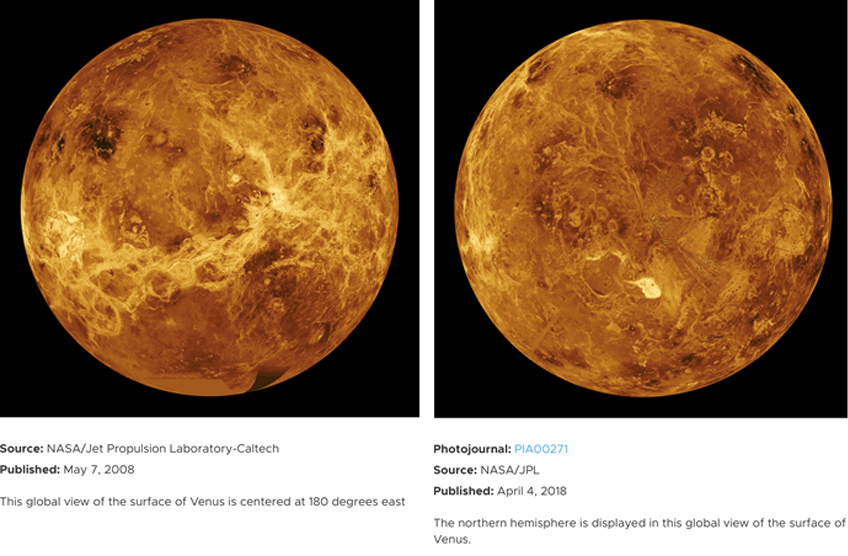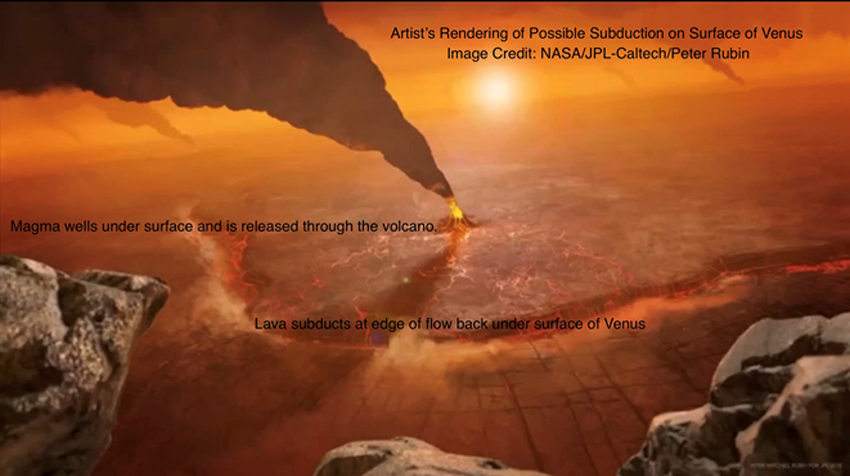Venus Update
by Laurie Averill
Volunteer Solar System Ambassador, JPL
This fall Venus will greet us in the pre-dawn eastern sky. When I look at our sister planet, I think of siblings that share so much, but are also very different and wonder why the Earth and Venus so different? Can we use what we know about these sister planets to identify exoplanets capable of sustaining us? The planets are similar. Venus is only five percent smaller than Earth. It has a similar density and bulk composition—made up of similar materials with similar structures. It has similar topography to Earth. Both Earth and Venus have clouds, precipitation, and winds. NASA’s Pioneer Venus 1 Mission also detected lightning.

Through dense cloud cover Synthetic Aperture Radar imaged the surface of Venus during the Magellan Mission from 1990-1994. It revealed mountain ranges, volcanoes, lava flows, craters, wind erosion, with rough, fresher areas reading as light and smooth, older areas reading as dark in the above color enhanced images of Venus. Based solely on its distance from the Sun, Venus’s temperature should not be much different from Earth’s. The presence of deuterium hydrogen, a surface marker for evaporated surface water, indicates that Venus once had enough surface water to fill a shallow ocean. 3.6 billion years ago, it may have been the first planet within our solar system’s habitable zone and having surface water.
Although Venus does not have plate tectonics, Dr. Suzanne Smrekar indicated that areas of subduction around active volcanoes may be possible. Magma may well up from beneath the surface where a volcano releases it. At the edge of the flow, the lava may subduct beneath the surrounding surface. This type of activity, when the lithosphere of Earth was much hotter than it is now, may have preceded plate tectonics on Earth. Varying levels of sulfur dioxide gas in the atmosphere are seen as evidence of recent volcanic activity by some scientists including Dr. Justin Filiberto and evidence of a cyclical, oscillations in the circulation of Venus’s atmosphere like El Niño and La Niña by Dr. Emmanuel Marcq based on data gathered by The European Space Agency’s Venus Express. Dr. Filiberto’s research also indicates that the volcanoes on Venus possibly have shield shapes like those in Hawaii that are lower to the surrounding area and produce layers of thin, viscous flows. Based on simulations of weathering on Venus of iron in a flow’s fresh olivine and basalt into hematite, he believes volcanic activity on Venus has occurred within 2.5 million years, possibly within 250,000 years and even more recently.

Venus and Earth are also different. Venus’s atmosphere is primarily made up of carbon dioxide, is very dense—the equivalent of being about 92 feet underwater—and traps the Sun’s heat. On Venus, the clouds obscure the surface at visible wavelengths and are made from droplets of sulfuric acid. They rain sulfuric acid, but it evaporates before reaching the surface. The dense, carbon dioxide atmosphere acts as a super greenhouse and traps the Sun’s heat, raising the planet’s surface temperatures to as high as 880 degrees Fahrenheit—hot enough to melt lead—hotter than Mercury’s surface even though Mercury is closer to the Sun. Venus rotates very slowly in the opposite direction of Earth. Each day on Venus lasts 243 Earth days. Recent observations by the Japan Aerospace Exploration Agency‘s Akatsuki Mission have detected mechanisms for heat distribution. Thermal tides in Venus’s lower clouds along the equator move 60 times faster than Venus rotates and disperse heat from the day side of Venus to the night side. A decades-long, global discontinuity of the deeper clouds—those closer to the surface—allows heat to also flow meridionally from the equator toward the north and south poles at slower rates.
